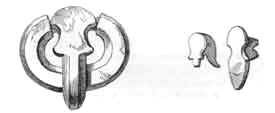|
across the blades of which, above the points, adheres a
piece of wood, or of some harder material, which had probably acted as a
keeper to prevent the opening of the blades when not required for use.1
A beautiful silver spoon, or strainer (Plate II., fig. 3), lay about the
centre of the body. Lower down, between the thigh-bones, was a large
crystal ball (Plate I., fig. 7), mounted in
silver-gilt, and near it two long fibula (Plate III., figs. 1, 2); all
these I will describe more fully below. The larger fibula, which is of
bronze, had rolled over as the body had decayed, and lay with its face
downward on the "os sacrum" of the skeleton, on which it had
impressed its shape and pattern with a green aerugo.
There were also two fragments of a bronze ferule, or
ferule-shaped casing, in which wood remains; fragments of a silver binding
or edging (much resembling in size and shape the brass edging so common on
the covers of prayer-books), in which also wood remains, and two of which
form right-angled corners; portions of silver wire ; a bronze |
|

buckle; two small rivets, or tags,
one of bronze, the other of silver; the fragments of a comb,
1. [I think Mr. Brent must be mistaken in his opinion of
this fragment adhering to the shears. It is certainly of bone or ivory,
and is, I cannot but think, a piece of comb, afterwards described as
found in a broken state, which has become fixed to the iron as it
rusted. A line remaining upon it corresponds to the ornament of the
comb, and in it is still one of the bronze nails or rivets, many of
which the comb has for fastenings – T.G.F.] |